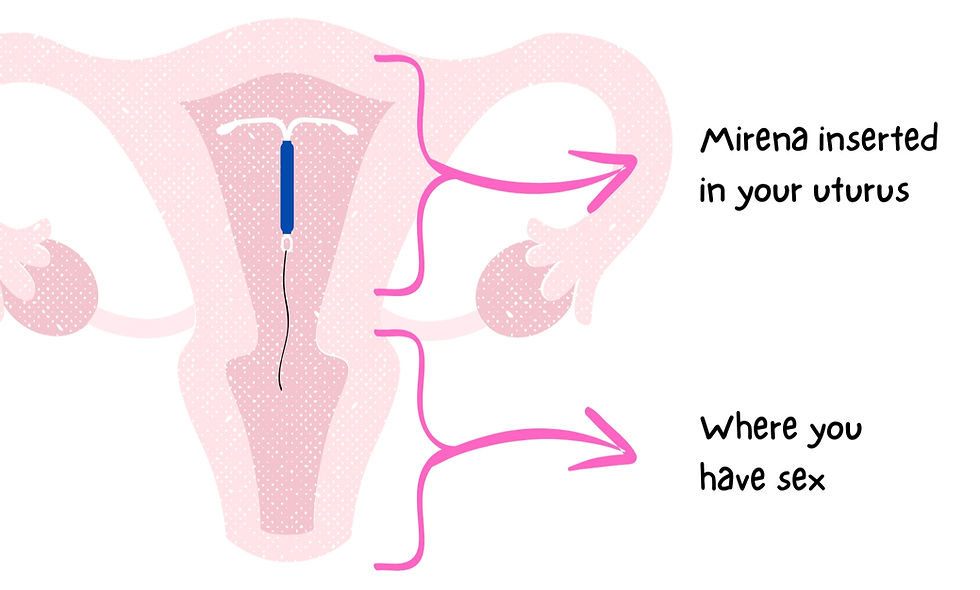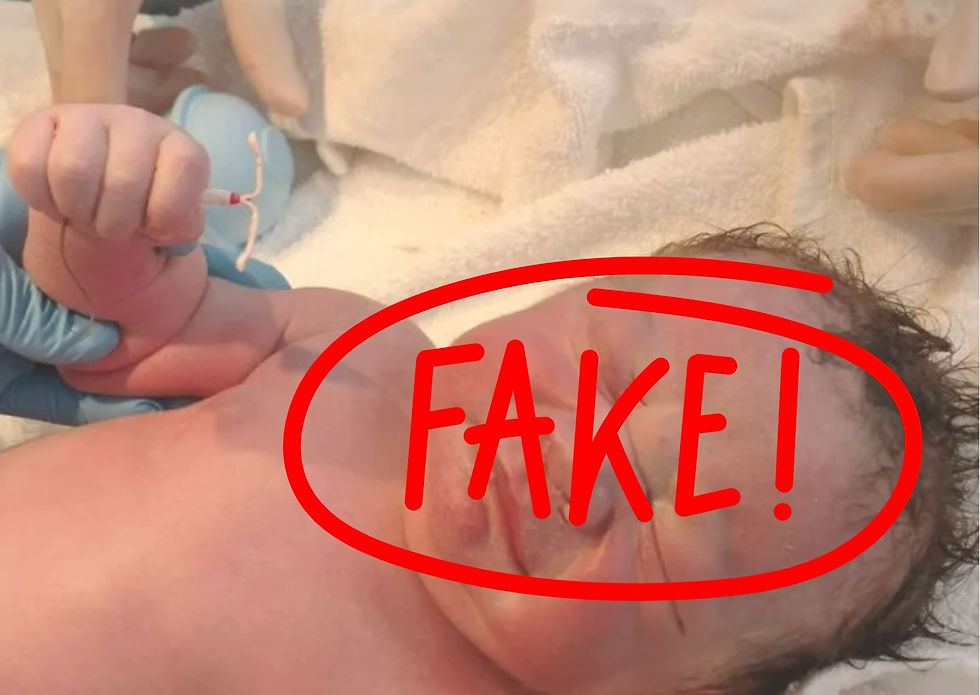Mirena Birth Control: Your Guide to the Hormonal IUD
- Samantha Pieterse
- Jul 31, 2024
- 7 min read
Updated: Apr 2
The Birth Control Revolution
The contraceptive revolution started in the 1960s. Suddenly, women were able to delay, space, and avoid pregnancies. Birth control has been life-saving for us as women. It is one of the cheapest and most empowering inventions, and we at Mums & Bums are here for it.
A Brief History of Contraception

The Mirena
The Mirena is a stand-out option thanks to amazing advancements in contraceptive management. Because it is a long-term option that doesn’t require much maintenance, the benefits include almost 100% effectiveness, long-term protection, and regulation of your period (or, in some cases, no period).
What is the Mirena?
So I’m sure you are wondering, “What is the Mirena?” The Mirena is a t-shaped plastic device that is put into your uterus. It works by releasing a steady stream of hormones into your system that can prevent pregnancy for up to 7 years.
How Does The Mirena Prevent Pregnancy?
The Mirena works in a couple of ways. Firstly, it thickens the mucus in your cervix, which prevents sperm from reaching the egg and fertilizing it. Secondly, it thins out the lining of your uterus so that if an egg were to be fertilized, it would not be able to implant. Lastly, the hormones in Mirena stop the release of an egg, which is called ovulation. This means that your body will not release eggs to be fertilized.
The Benefits of The Mirena
There are so many benefits to using this as a method of contraception:
The Mirena is effective for up to 7 years. This means if you have completed your family, the Mirena is a great option for a long-term contraceptive until you reach menopause.
It is convenient. Unlike the pill, which you need to remember to take at the same time each day and need to collect once a month, when the Mirena is placed, it is in and effective for 7 years. The only maintenance it requires from your side is checking that you can feel the strings once a month after your period.
There is a lower risk of pregnancy due to your error because once it is in, you don’t need to remember anything except for string checks and replacing it every 7 years.
There are also some non-contraceptive benefits, such as possible reduction in menstrual bleeding and cycle regulation.
Who Can Use Mirena?
Almost all women are suitable candidates for the Mirena, but if you have the following, you may benefit even more from having the Mirena placed:
Heavy bleeding during periods
Severe pain or cramping during periods
Endometriosis
Anaemia
Fibroids
Who Cannot Use the Mirena?
As with anything medical, this option is not suitable for everyone. If you have any of the following, you may better benefit from another contraceptive option:
Have or have had breast cancer
Have or have had uterine or cervical cancer
Liver disease
Fibroids that hinder the placement of the Mirena
Pelvic infection or pelvic inflammatory disease
Atypically shaped uterus
Migraines
Blood clotting disorders
Mirena Insertion: What to Expect
Consultation for the Mirena
During your visit, we will discuss whether Mirena is the right contraceptive method for you. You are welcome to use this opportunity to ask questions and address any concerns.
Medical History: we will ask you some questions about your medical history, including any previous pregnancies, menstrual cycle details, and medical conditions or allergies.
Pre-insertion preparation
The timing of the insertion can be important. While we don’t mind where in your cycle you are, it may be more comfortable to schedule the insertion during your period. This is because your cervix is naturally more open, making the process easier and less painful.
Medications: we suggest taking a pain reliever (like ibuprofen) an hour before the appointment to help manage discomfort during and after the procedure.
Arrival: Arrive at your appointment early to complete any necessary paperwork and relax before the procedure.
The Insertion Procedure
Examination: We perform a pelvic exam to check the position and size of your uterus and cervix.
Positioning: You’ll lie on the bed with your legs bent at the knees and your feet flat on the bed, similar to a pap smear.
Cleaning and Numbing: A speculum will be inserted so that we can see your cervix; this is a device that is used to open the vagina (in the same way that is done during a pap smear. We then clean your cervix and apply a numbing gel to minimize discomfort.
Measuring the Uterus: We will measure the depth of your uterus using a small instrument to ensure the proper placement of the Mirena.
Inserting the Device: The Mirena IUD, a small T-shaped device, is inserted through the cervix and into the uterus using a thin, flexible tube. During this part of the process, you may feel some cramping or discomfort.
Final Adjustments: The provider will trim the strings of the IUD to about 2-3 cm, which you’ll be able to feel high in your vaginal canal.
I know this all sounds very scary, but at Mums & Bums, we really strive to make this appointment as quick and comfortable as possible. The whole procedure of inserting takes no more than 5 minutes, including a pap smear if needed.
Post-Insertion Care
Rest and Recovery: After the insertion, you might experience cramping and spotting. Rest and use over-the-counter pain relievers as needed.
Follow-Up Appointment: Schedule a follow-up visit 6 weeks after the insertion to ensure the IUD is properly placed and to address any concerns.
Mirena Removal: What to Expect
Common Myths and Misconceptions About The Mirena
Myth 1: My partner will be able to feel the device during intercourse.
Fact: Intrauterine devices such as the Mirena are inserted into the uterus, which is much higher up than where you will be having intercourse (vagina).

Myth 2: Women who have never been pregnant may not get a Mirena.
Fact: Not having a previous pregnancy is not a contraindication for the Mirena. This may be a great option for many women, regardless of if you have been pregnant before.
Myth 3: The Mirena is not safe; many women have babies who are born with the Mirena in their hands.
Fact: While there is no one method that is 100% effective in preventing pregnancy, intrauterine devices such as the Mirena and Copper-T are the number one most effective contraception methods. Less than 1% of women with an intrauterine device become pregnant while using this method.

Comparing The Mirena to Other Birth Control Options
Method | Effectivity | Effective Time | Effect on Period | Ease of Use |
Mirena/Kyleena | >99% | 3 – 5 years | May take your period away completely | 4/5
No additional effort is required besides string checks. |
Copper T/Loop | >99% | 7 – 10 years | No effect on your period | 4/5
No additional effort is required besides string checks. |
Implant | 99% | 3 years | May take your period away completely | 5/5
No additional effort is required. |
Injection | 96% | 2 or 3 months | It may take away or greatly reduce your period | 4/5
No additional effort is required. However, you must attend the clinic every 2 – 3 months to receive the injection. |
Pill | 92% | Monthly (or daily – it’s not effective if you miss one) | It may help to regulate your period. | 1/5
You need to remember to take it at the same time each day. |
Patch | 91% | Weekly (needs to be changed for it to be effective) | It may help to regulate your period. | 3/5
You need to change it weekly, but you don’t need to remember to do it each day. |
Condoms | 98%
If used correctly | One sex act | None | 0/5
It needs to be used correctly each time. |
Pull Out Method (Coitus-Interruptus) | 80% | One sex act | None | 0/5
It can be risky if not done in time. |
Conclusion: Is Mirena Right for You?
Whether Mirena is right for you depends entirely on you. Contraception is not a one-size-fits-all approach. Each of your circumstances and issues needs to be considered before choosing the method you want to try.
Make an appointment at Mums & Bums today, and we will walk you through your options.














Comments